As Bitcoin approaches $120,000, you're witnessing a potential shift that could redefine your view on wealth. Unlike gold's stability, Bitcoin's volatility offers high rewards, reflecting a growing trend toward digital investments. The approval of spot ETFs is already making waves, enhancing market confidence. With Bitcoin's capped supply boosting its deflationary nature and gold remaining a reliable safe haven, each asset serves unique purposes. If you're considering diversifying your portfolio, understanding these dynamics is essential. Explore how this pivotal moment could reshape your investment strategies and the broader financial landscape.
Key Takeaways
- Bitcoin's projected price surge to $120K could position it as a primary alternative to traditional assets like gold, attracting more institutional investment.
- The deflationary nature of Bitcoin, with its capped supply, contrasts with gold's annual supply increase, enhancing Bitcoin's appeal amid inflation concerns.
- Regulatory clarity and the approval of spot ETFs have boosted Bitcoin's market confidence, potentially driving it to unprecedented price levels.
- As market volatility persists, Bitcoin's high potential returns may attract investors seeking growth, while gold remains a stable safe-haven asset.
- A Bitcoin price of $120K could shift investor focus from gold to crypto, redefining asset allocation strategies and investment norms in finance.
Market Performance Overview

As Bitcoin's value surged by 150% entering 2024, you can't help but notice the notable shifts in the cryptocurrency market. Starting the year at around $44,000, Bitcoin reached nearly $70,000 by late May. Experts are optimistic, predicting that Bitcoin could hit $77,000 by the end of 2024 and soar to $123,000 by the end of 2025. This rapid growth has reignited interest among institutional investors, with several major financial firms exploring opportunities in the crypto space. Additionally, discussions surrounding Bitcoin’s $100k milestone prediction have gained momentum, further fueling market speculation and investment. As regulatory clarity improves in key regions, many believe these factors could help solidify Bitcoin’s position as a mainstream asset.
Currently, it's trading at about $93,900, with a forecasted range between $95,440.78 and $107,264.36 in December 2024, and an average trading price of around $101,352.57. The increasing demand for Bitcoin investments has been fueled by the approval of spot ETFs, which has significantly influenced market dynamics.
However, the journey hasn't been without hiccups. In Q3 2024, you witnessed sharp corrections, including a decline of over 12% in July and August. Factors like macroeconomic conditions and interest rate changes contributed to this volatility.
Yet, after a dip below $50,000 in August, Bitcoin rebounded by 7.39% in September, showcasing its resilience.
The approval of spot ETFs in January 2024 and the Bitcoin halving event in April played pivotal roles in driving demand, highlighting how external catalysts can notably impact market performance.
Understanding Volatility and Risk
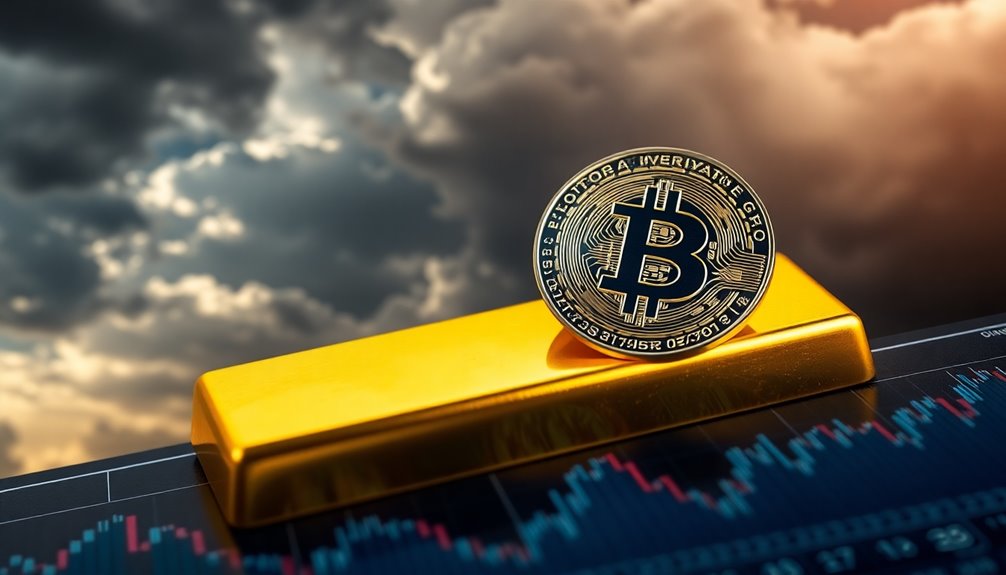
When you compare Bitcoin to gold, you'll notice stark differences in price fluctuations and stability factors. While Bitcoin's value can swing wildly due to market dynamics and investor sentiment, gold tends to offer a more stable investment. Understanding these differences is essential for evaluating your risk as an investor. This volatility is reflected in Bitcoin's annualized return of approximately 110%, significantly outpacing traditional assets like gold. Additionally, gold's historical performance as a hedge against inflation further underscores its role in a diversified portfolio.
Bitcoin's Price Fluctuations
Bitcoin's price fluctuations are strikingly influenced by a mix of supply and demand dynamics, regulatory changes, and market behavior. With a fixed supply of 21 million coins, Bitcoin's value can swing dramatically based on demand. The halving mechanism, which reduces mining rewards every four years, adds another layer of complexity, often spurring price surges amid rising demand, especially during economic uncertainty. This unique value proposition has attracted traders and investors due to the potential for high returns, while also presenting significant risks associated with unpredictable price movements. Additionally, the advent of NLP technology in trading platforms has improved the analysis of market sentiment, enabling more informed investment decisions.
Regulatory actions also play an essential role. For instance, when China banned Bitcoin activities, it triggered a sharp price drop. Conversely, the anticipation of positive regulatory changes, like spot Bitcoin ETFs, can boost prices.
Economic factors, such as interest rate changes, further contribute to volatility, making Bitcoin's price movements more erratic compared to traditional assets. Additionally, the market's speculative nature means that retail investors greatly drive Bitcoin's price, exposing it to panic-induced fluctuations.
Historical data shows Bitcoin's volatility is higher than both gold and major currencies, with daily realized volatility ranging from 2.49% to 8.26%. Despite this volatility, the potential for high returns remains attractive, as indicated by its favorable Sharpe and Sortino ratios.
Gold's Stability Factors
While Bitcoin's price swings can be dramatic, gold often stands out for its stability in the face of economic turmoil. When geopolitical instability arises—like political unrest or wars—demand for gold typically spikes. This safe-haven asset becomes particularly appealing when currencies devalue due to economic sanctions or radical leadership changes.
Supply chain disruptions in major gold-producing regions can also elevate prices, reflecting gold's finite nature. As annual gold production remains relatively low compared to demand spikes, this scarcity further supports gold's value during uncertain times. Additionally, gold IRAs can provide tax advantages that enhance long-term investment strategies for retirement portfolios. The concept of diversification strategy is crucial, as including gold in a portfolio can mitigate overall investment risk. Furthermore, investing in gold through a Gold IRA allows for potential tax-deferred growth, which can significantly benefit retirement planning. Investing in a Bitcoin IRA can complement gold holdings, offering further diversification and growth potential. Moreover, precious metals like gold are known to serve as a hedge against inflation, making them an essential part of a robust investment strategy.
The dynamics of supply and demand play an essential role. When mining companies discover large deposits, prices may drop, but high demand usually keeps them buoyant. Central banks actively influence the market by buying or selling gold reserves, impacting the overall price.
Fluctuations in currency and market conditions are key factors as well. A weaker U.S. dollar often makes gold cheaper for international investors, driving up demand. Additionally, low-interest rates boost gold's attractiveness, while strong economic performance can lead to declines in gold prices as investors liquidate their assets.
Investor Risk Assessment
Steering through the world of investments requires a keen understanding of volatility and risk, especially in the case of Bitcoin. Unlike traditional equities, Bitcoin showcases high volatility, often exceeding 200% in its early years and remaining three to four times more volatile than various equity indices from 2020 to 2024. Since early 2020, there has been approximately 400% growth in the number of traded coins/tokens, further amplifying market dynamics.
While its volatility is declining as the market matures, it has still experienced multiple 50% corrections throughout its 15-year history, recovering to new all-time highs each time.
Several factors contribute to Bitcoin's volatility, including limited supply and market speculation. As new participants enter the market, price discovery fluctuations can be significant.
Regulatory uncertainty and liquidity issues further exacerbate these price movements.
When evaluating risk, metrics like the Sharpe and Sortino ratios indicate that Bitcoin investors are compensated for the risks they take.
However, employing risk management strategies is essential. You might consider diversification across asset classes, utilizing stop-loss orders, and leveraging advanced options tools for enhanced control.
Understanding these elements will empower you to navigate Bitcoin's volatile landscape more effectively.
Future Predictions for Bitcoin
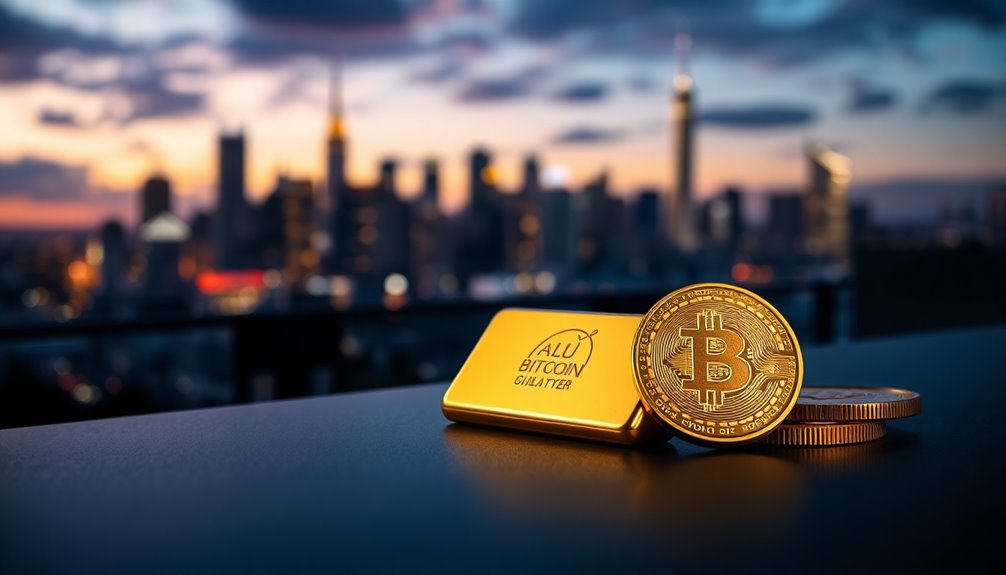
As investors gear up for the upcoming years, future predictions for Bitcoin suggest a rollercoaster ride of price fluctuations and market trends. In the short term, you might see Bitcoin ranging between $45,000 and $100,000 in 2024, with heightened buying interest expected later in the year. Monthly fluctuations could have you watching closely, especially in October when a potential bull run could emerge.
Here are three key takeaways for you to reflect upon:
- Support and Resistance: Bitcoin's support levels are likely to hold above $41,000, but resistance may hover around $60,000 to $70,000.
- Medium-Term Targets: By 2025, analysts predict Bitcoin could reach between $65,000 and $200,000, driven by strong institutional inflows into Bitcoin ETFs, with some forecasts indicating targets exceeding $150,000.
- Long-Term Growth: Looking further ahead, projections suggest Bitcoin could hit $210,000 by 2027, with substantial market growth fueled by increased adoption and technological advancements.
Navigating through these predictions could help you strategize your investments in this ever-evolving market.
The Regulatory Landscape

The future of Bitcoin isn't just shaped by market trends and price predictions; regulatory frameworks are playing a significant role in its evolution.
As the European Union moves toward implementing the MiCA regulations, effective from June 30, 2024, you'll see an increased focus on licensing requirements for crypto-asset service providers. By January 2026, these companies must identify senders and beneficiaries for all transactions, enhancing transparency. This aligns with the World Economic Forum's focus on enhancing global trade and investment through collaborative initiatives.
Globally, regulatory trends are tightening. The FATF is enforcing the Travel Rule for crypto transactions, pushing jurisdictions to comply.
The IOSCO has issued recommendations aimed at ensuring investor protection and market transparency, influencing regulations worldwide. Meanwhile, in the U.S., the SEC and CFTC are actively enforcing existing laws on crypto, leading to ongoing legal battles and varied state-level regulations.
As countries like Australia and the UK develop their frameworks, you can expect a more structured approach to cryptocurrencies.
With this evolving regulatory landscape, investors must stay informed, as compliance will dictate how Bitcoin and other digital assets are traded and perceived in the market.
Investment Goals and Strategies
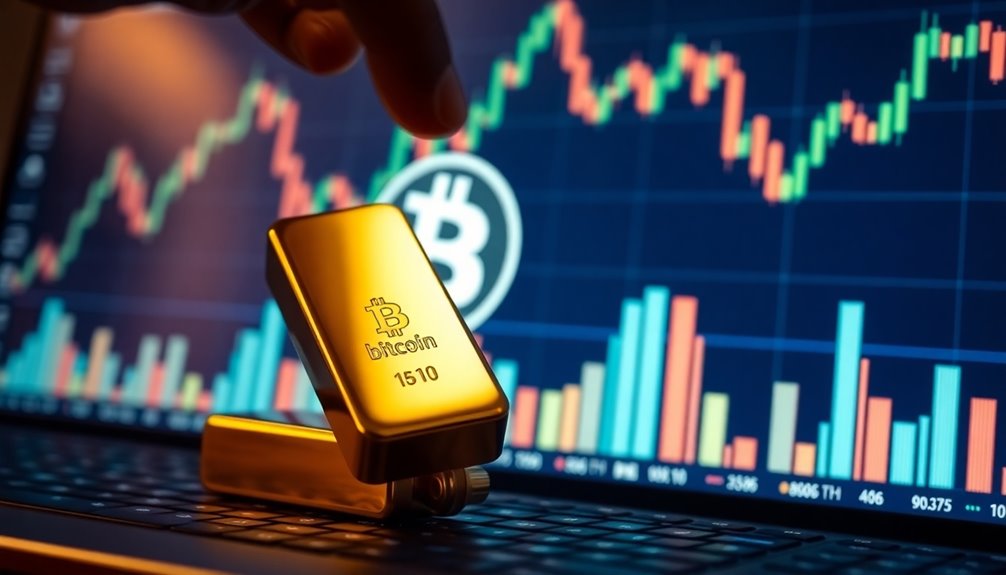
Investment goals and strategies are essential elements for anyone looking to navigate the volatile world of Bitcoin. With the right approach, you can optimize your investments and potentially reap significant rewards. Here are three strategies to evaluate:
- HODLing: This long-term strategy involves buying Bitcoin and holding it through market ups and downs, trusting in its future growth potential. Patience is key here, as you'll need to withstand market fluctuations.
- Dollar-Cost Averaging (DCA): By investing a fixed amount of money at regular intervals, you can mitigate risk and lower your average cost over time. This disciplined approach is particularly effective in a volatile market, providing a steady way to build your Bitcoin holdings. Additionally, the capped supply of Bitcoin at 21 million coins reinforces its scarcity, which can drive value appreciation over time.
- Diversification: Don't put all your eggs in one basket. Spread your investments across multiple cryptocurrencies and assets to protect yourself against unexpected market shifts. A balanced portfolio can help you achieve better risk-adjusted returns.
Unique Features of Bitcoin
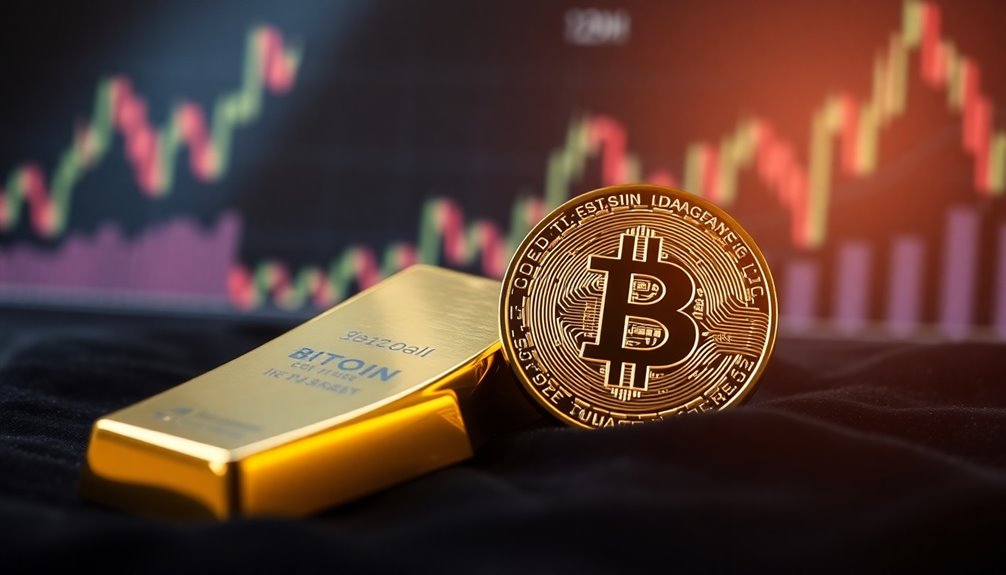
Exploring the unique features of Bitcoin reveals why it's become a revolutionary asset in the financial landscape. Its decentralization guarantees that no central authority controls the network, making it resilient and accessible for everyone. Each participant can run a node or create a wallet, promoting a trustless environment where transactions are verified collectively. This validation process ensures that all nodes must reach unanimous consensus before adding new blocks, further enhancing security. Additionally, many investors utilize Bitcoin IRAs to manage their retirement savings with tax advantages.
The immutability of Bitcoin's blockchain means that once a transaction is recorded, it can't be altered or deleted. This transparency builds trust among users, as all transactions are time-stamped and available for public scrutiny.
Additionally, Bitcoin offers censorship resistance and privacy. You conduct transactions directly, avoiding intermediaries that could impose restrictions. While exchanges may require identification, you can create wallets independently to maintain anonymity.
Lastly, Bitcoin's capped supply of 21 million coins introduces a deflationary aspect that distinguishes it from traditional assets. This limited supply enhances its value over time, as demand continues to grow.
| Feature | Benefit | Significance |
|---|---|---|
| Decentralization | No central control | Resilience against failures |
| Immutability | Trustworthy transactions | Transparency and reliability |
| Capped supply | Deflationary nature | Potential for increasing value
Gold's Stability and Use Cases
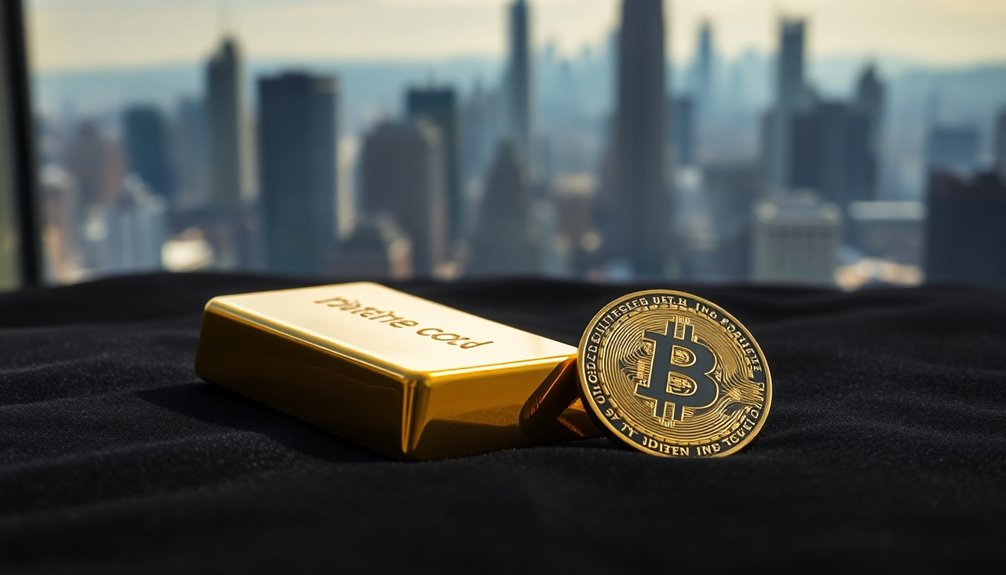
When you think about gold, its historical reliability as a store of value stands out. You might also consider how its demand in industries and jewelry adds to its stability in uncertain markets. Together, these factors make gold a unique asset worth exploring further. Additionally, gold has consistently proven to be a strong hedge against market volatility during periods of economic uncertainty. Gold IRAs offer tax advantages and potential for long-term capital appreciation, further enhancing its appeal as a safe haven investment. Furthermore, diversification across various cryptocurrencies within a Bitcoin IRA can complement traditional investments like gold, providing a balanced approach to risk management. Notably, IRS regulations surrounding Gold IRAs ensure that investments are safeguarded and compliant, which is essential for long-term financial planning. Moreover, gold's role as a hedge against inflation makes it particularly attractive during times of economic stress, further solidifying its position in investment portfolios. Additionally, investing in gold enhances portfolio diversification, which can lead to improved risk management strategies.
Historical Reliability of Gold
Gold has long stood the test of time as a reliable store of value, earning trust and significance through centuries of use. Its historical reliability is rooted in key factors that make it a go-to asset during turbulent times.
- Economic Stability: The gold standard, adopted by countries like the UK and US, tied currencies to gold, reducing inflation risk and fostering economic trust. Even during conflicts like World War I, gold demand surged, proving its stability. Notably, the historical average annual return of gold is 7.98% since 1971, reflecting its long-term growth and resilience.
- Performance During Crises: Whenever economic uncertainty arises, gold shines. From the 1970s oil crises to the 2008 Global Financial Crisis, gold prices have rallied, often reaching new highs as other assets falter.
- Inflation Hedge: Gold's appeal grows in inflationary environments. For example, between 2003 and 2006, gold prices doubled due to rising inflation and low interest rates. It acts as a safeguard for purchasing power, often thriving when real yields decline.
With a track record that spans centuries, gold remains a steadfast asset, proving its worth even as financial landscapes evolve.
Industrial and Jewelry Demand
The historical reliability of gold as a store of value is complemented by its significant industrial and jewelry demand, showcasing its versatility in various applications. In the industrial sector, gold plays a vital role, particularly in the electronics field, where it accounts for about 80% of gold usage. Its unique properties make it irreplaceable in high-end devices, from consumer electronics to medical devices. Additionally, gold's integral role in global central bank reserves highlights its importance as a stable asset in times of economic uncertainty. Furthermore, Noble Gold's offerings in the gold IRA market emphasize the growing interest in gold as a retirement investment. Moreover, the importance of understanding how gold is used in various industries can help investors make informed decisions about its value. Notably, antimicrobial properties of gold contribute to its appeal in medical applications, further enhancing its industrial relevance. In addition, the HEPA filters used in air purifiers can significantly improve indoor air quality, which is essential for maintaining a healthy living environment, especially for those working in tech-heavy industries. Furthermore, the use of renewable resources in industries like wood heating demonstrates a growing trend towards sustainability, which can parallel the stability gold offers during economic fluctuations.
On the jewelry front, gold remains a favorite, with approximately 48-50% of global demand stemming from this sector. Countries like India and China dominate this market, with cultural practices driving consistent demand. As you can see in the table below, both industrial and jewelry demands are influenced by various factors:
| Sector | Key Facts | Impact on Demand |
|---|---|---|
| Industrial | 80% usage in electronics | Growth with tech trends |
| Jewelry | 48-50% global demand | Driven by culture |
| Major Consumers | India & China lead | Economic sensitivity |
With technological advancements and cultural significance intertwined, gold's dual demand continues to reinforce its status as a valuable asset in today's financial landscape.
Comparing Long-Term Value

Historically, investors have sought assets that provide long-term value, and the comparison between Bitcoin and gold presents a fascinating study in contrasting characteristics. On one hand, Bitcoin's fixed supply of 21 million coins creates predictable scarcity, while gold's supply increases by 1.5–2% annually due to mining. This difference can greatly impact their long-term value.
When evaluating these assets, consider the following factors:
- Stability vs. Volatility: Gold has historically shown stability, retaining value over time, while Bitcoin's price can swing wildly, offering both high gains and steep losses. The rising ratio of Bitcoin to gold indicates Bitcoin's potential outperformance in the long term.
- Portability and Liquidity: Bitcoin shines with its ease of transfer and 24/7 market access, whereas gold is cumbersome to move and trade, though it remains liquid in established markets.
- Regulatory Environment: Gold operates under a stable regulatory framework, while Bitcoin's evolving landscape can introduce uncertainties, affecting its long-term outlook.
As you weigh these elements, think about your investment goals and how each asset aligns with your strategy for long-term value.
Frequently Asked Questions
How Can I Securely Store My Bitcoin Investments?
To securely store your Bitcoin investments, consider using a hardware wallet for offline protection.
Keep your private keys away from the internet to minimize hacking risks. Additionally, create backups of your keys and store them in a safe place.
Using a mix of hot and cold wallets can enhance security, allowing you to maintain control while still having access for trading.
Stay vigilant against phishing scams and always use strong passwords.
What Are the Tax Implications of Investing in Bitcoin?
When you invest in Bitcoin, it's essential to understand the tax implications.
You'll face capital gains tax when you sell or trade your Bitcoin, with rates depending on how long you held it.
You must report all transactions to the IRS, using the fair market value at the time of each transaction.
Keeping accurate records helps guarantee you navigate these tax requirements smoothly and avoid any unexpected liabilities.
How Does Bitcoin Mining Impact Its Price?
Bitcoin mining greatly impacts its price through various factors.
When mining costs rise, especially due to energy expenses, it affects miners' profitability, which can lead to less mining activity and a decrease in the hash rate.
Conversely, when Bitcoin's price increases, it attracts more miners, boosting the network's security and hash rate.
Additionally, events like halving reduce rewards, prompting miners to adapt, which can drive price fluctuations in the market.
Can Bitcoin Be Used for Everyday Transactions?
Imagine a bustling market where coins jingle and trades flourish. In this vibrant scene, Bitcoin can indeed be your everyday currency. You can buy groceries or grab a coffee with it, just as you'd with cash.
However, keep in mind that its value can swing like a pendulum. While it's gaining traction for daily use, familiarity and acceptance still vary.
What Are the Environmental Concerns Related to Bitcoin Mining?
When you think about Bitcoin mining, you'll notice significant environmental concerns.
It consumes a staggering amount of electricity, mainly from fossil fuels, contributing to high carbon emissions. Each dollar mined damages the climate, comparable to emissions from entire countries.
You'll also see the issue of electronic waste from outdated mining hardware and the substantial water and land footprints it creates.
Conclusion
In 2023, Bitcoin's potential to hit $120k could reshape the financial landscape, especially when you consider that Bitcoin's price volatility is about three times greater than gold's. This stark difference highlights the unique risk-reward dynamic of investing in digital assets. As you weigh your options, remember that while Bitcoin offers innovative opportunities, gold's stability remains a reliable hedge. Understanding these nuances can help you make informed decisions that align with your investment goals.










